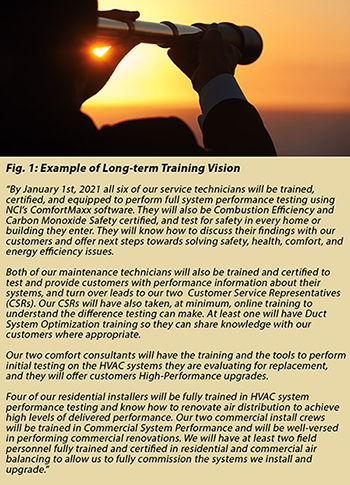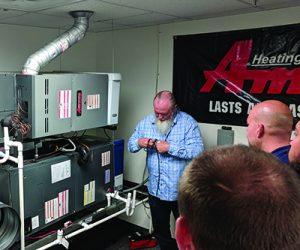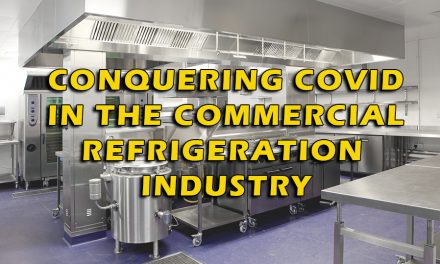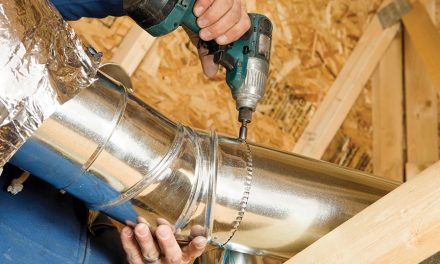 Set Short and Long-Term Goals
Set Short and Long-Term Goals
Once you’ve determined a comfortable pace to invest in training, it’s time to set some measurable, quantifiable goals against which you can determine your progress as you move forward.
Short and long-term goals are equally important. If you only focus on long-term goals you may find it difficult to stay the course, as the goals may seem so far off it’s hard to gauge where you are in the process. Remember the old adage, ‘the way to eat an elephant is one bite at a time.’
 It’s still important to have long-term goals when it comes to training the troops and achieving the end result you want.
It’s still important to have long-term goals when it comes to training the troops and achieving the end result you want.
Consider creating a ‘Training Vision Statement.’ Put together a concise, but detailed vision of what your company’s workforce will look like in the future. Choose your goal date based on how slow or fast you want to bake performance-based contracting into your company culture.
If you want to take it slow, it might take as long as three to five years. If you are on a fast-track, your long-term target may be one or two years.
As you spell out your vision, describe the end-result in clear, measurable terms that you can look at every few months and determine if you are on track, and what course corrections you need to make. Figure 1 illustrates what a long term vision might look like.
Short term goals should be reasonably achievable in six months or less. They can even be 30-day goals. The value of setting these goals is they can provide fairly quick wins that can help you build momentum, and get your team excited about what you are doing differently.
A short-term goal can be as simple as getting two service techs trained and certified to test static pressure ‘ and be able to discuss the results with your customer — within 30 days. Think about chopping up your long term goals into more manageable plans in the months ahead.
Be sure to document your progress as you move on to each next step. You will be amazed at how much you’ll accomplish with this approach.

Individual Knowledge, Skills, and Abilities
Training is not a one-size-fits-all process. Each employee should receive training based on where they are in their career path.
A great first step is to create a process by which you interview each team member to assess his or her work experience, formal training, and education. Be sure to also ask them about their perceived skillsets.
- What do they think they are good at?
- Where do they think they need to improve?
An open, non-judgmental conversation will go a long way towards a fair and accurate evaluation.
Technical employees will also benefit from a formal knowledge assessment test. There are some online tests specific to our industry.
HVACRedu.net, for example, offers a low cost ‘Technical Core Assessment Exam,’ that can help you determine knowledge levels, and whether the individual needs significant training, or just a brushing up on core knowledge.
For non-technical personnel there are many great web-based assessment services that can help you assess KSAs (knowledge, skills, and abilities) for each type of role.
A Personality Profile assessment can also be a valuable tool to help you understand a person’s strengths and weaknesses as well as whether they are in the right type of role. You can find good online services that use methods such as DISC and Meyers Briggs for this task. It’s worthwhile to do this testing with both technical and non-technical personnel.
 Assign Training By Roles and Needs
Assign Training By Roles and Needs
Once you have assessed each team member’s KSAs, you can initiate the training required for each role to move the company towards your short and long-term goals.
Following are descriptions of training needs by role for a typical mid-sized HVAC contracting business on the path to High Performance. Of course, you need to make adjustments based on your company’s size, structure, and type of work you do.
 You and some of your team may wear more than one hat. The list below is based primarily on technical training needs. You also need to add non-technical and soft-skills training based on roles and responsibilities.
You and some of your team may wear more than one hat. The list below is based primarily on technical training needs. You also need to add non-technical and soft-skills training based on roles and responsibilities.
Ideally, your management team should be on board with the overall training direction first, then make sure they train with your field and office personnel. This helps assure they have a throrough understanding of what their team is learning, so they can integrate this knowledge into the company’s culture.
Maintenance Technicians: If this is an entry-level position in your company, your maintenance techs should learn how to measure static pressure and interpret airflow at the equipment. They should also be trained on how to inform your customer on how their system is performing based on those readings.
In addition to good internal reinforcement training, you may want to consider a Duct System Optimization class for these individuals. They should also take Combustion and CO Safety training to make sure they know how to perform proper CO safety testing.
While they may learn more than they need right away, it will give them room to grow as they move up the path to becoming service technicians.
Service Technicians: From an airflow and performance perspective, your service techs will benefit most from Duct System Optimization training, followed by a Residential System Performance certification class between three and six months later.
Typically, it’s best to space these classes apart to allow them to apply their newly learned skills in the field before progressing to the next step.
For those companies that do commercial work, there is a similar track that covers Commercial System Performance.
Be sure to get all of your Service Techs Combustion and CO Safety certified as soon as possible. Not only will this reduce your liability, they will quickly uncover and correct many long-standing issues.
This knowledge will help keep your customers safe, while generating opportunities for profitable venting and combustion air repairs ‘ even equipment replacement. And don’t forget to equip your techs with Low Level CO Monitors!
Service Manager and Lead Technicians: In addition to Performance-Based implementation training and coaching, your Service Manager should take the same training as your service techs. Even if he or she is not a field person, it’s important they understand and support what your techs are doing differently.
Your lead technicians, who may or may not be your Service Manager, should take as many of these classes as possible.
If this person also handles the final commissioning of installations and/or duct renovations, he or she should also become Air Balancing certified. This helps ensure they can seamlessly go from dialing in airflow for each room, to tuning the refrigerant side for optimum system performance.
Installers: To deliver High-Performance installations, it’s essential that your installers take Duct System Optimization training.
This helps them to significantly improve installations right off the bat. It’s also good for them to undergo Combustion and CO Safety training.












Recent Comments